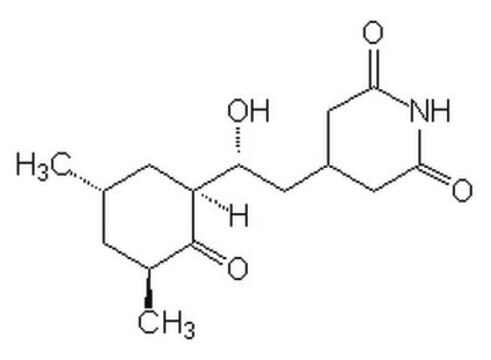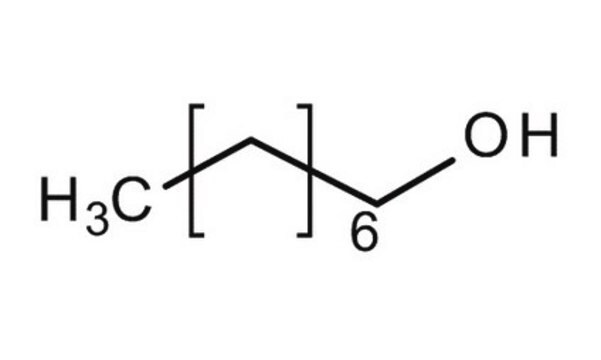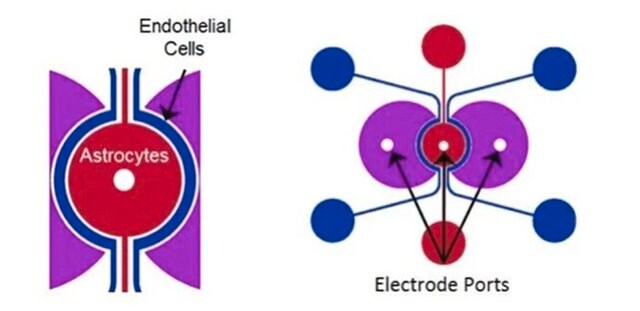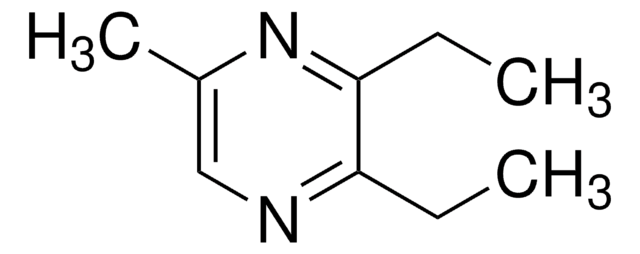W236500
1-Decanol
≥98%, FCC, FG
Synonim(y):
n-Decyl alcohol, Alcohol C10
About This Item
Polecane produkty
pochodzenie biologiczne
synthetic
Poziom jakości
klasa czystości
FG
Halal
Kosher
agency
meets purity specifications of JECFA
zgodność regionalna
EU Regulation 1334/2008 & 178/2002
FCC
FDA 21 CFR 117
FDA 21 CFR 172.515
gęstość pary
4.5 (vs air)
ciśnienie pary
1 mmHg ( 70 °C)
8.25 mmHg ( 100 °C)
Próba
≥98%
temp. samozapłonu
550 °F
współczynnik refrakcji
n20/D 1.437 (lit.)
tw
231 °C (lit.)
mp
5-7 °C (lit.)
rozpuszczalność
ethanol: 60%, clear, colorless (1mL/3mL)
gęstość
0.829 g/mL at 25 °C (lit.)
Zastosowanie
flavors and fragrances
Dokumentacja
see Safety & Documentation for available documents
alergen pokarmowy
coconut
Organoleptyczne
fatty; waxy; fruity; rose
ciąg SMILES
CCCCCCCCCCO
InChI
1S/C10H22O/c1-2-3-4-5-6-7-8-9-10-11/h11H,2-10H2,1H3
Klucz InChI
MWKFXSUHUHTGQN-UHFFFAOYSA-N
Szukasz podobnych produktów? Odwiedź Przewodnik dotyczący porównywania produktów
Opis ogólny
Zastosowanie
- Electroextraction of methylene blue from aqueous environmental samples using paper points coupled with hollow fiber membranes.: This research investigates a novel method for removing methylene blue from water using 1-Decanol. The findings demonstrate the effectiveness of this approach in environmental cleanup applications, emphasizing the versatility of 1-Decanol in extraction processes (Orlando et al., 2024).
- Multi-objective optimization of ternary blends of Algal biodiesel-diesel-1-decanol to mitigate environmental pollution in powering a diesel engine using RSM, ANOVA, and artificial bee colony.: This study explores the use of 1-Decanol in creating eco-friendly fuel blends. The results indicate significant reductions in emissions and improvements in engine performance, demonstrating the environmental benefits of incorporating 1-Decanol in biodiesel formulations (Alruqi et al., 2023).
Hasło ostrzegawcze
Warning
Zwroty wskazujące rodzaj zagrożenia
Zwroty wskazujące środki ostrożności
Klasyfikacja zagrożeń
Aquatic Chronic 3 - Eye Irrit. 2
Kod klasy składowania
10 - Combustible liquids
Klasa zagrożenia wodnego (WGK)
WGK 1
Temperatura zapłonu (°F)
203.0 °F - Pensky-Martens closed cup
Temperatura zapłonu (°C)
95 °C - Pensky-Martens closed cup
Środki ochrony indywidualnej
Eyeshields, Faceshields, Gloves, type ABEK (EN14387) respirator filter
Certyfikaty analizy (CoA)
Poszukaj Certyfikaty analizy (CoA), wpisując numer partii/serii produktów. Numery serii i partii można znaleźć na etykiecie produktu po słowach „seria” lub „partia”.
Masz już ten produkt?
Dokumenty związane z niedawno zakupionymi produktami zostały zamieszczone w Bibliotece dokumentów.
Klienci oglądali również te produkty
Nasz zespół naukowców ma doświadczenie we wszystkich obszarach badań, w tym w naukach przyrodniczych, materiałoznawstwie, syntezie chemicznej, chromatografii, analityce i wielu innych dziedzinach.
Skontaktuj się z zespołem ds. pomocy technicznej











